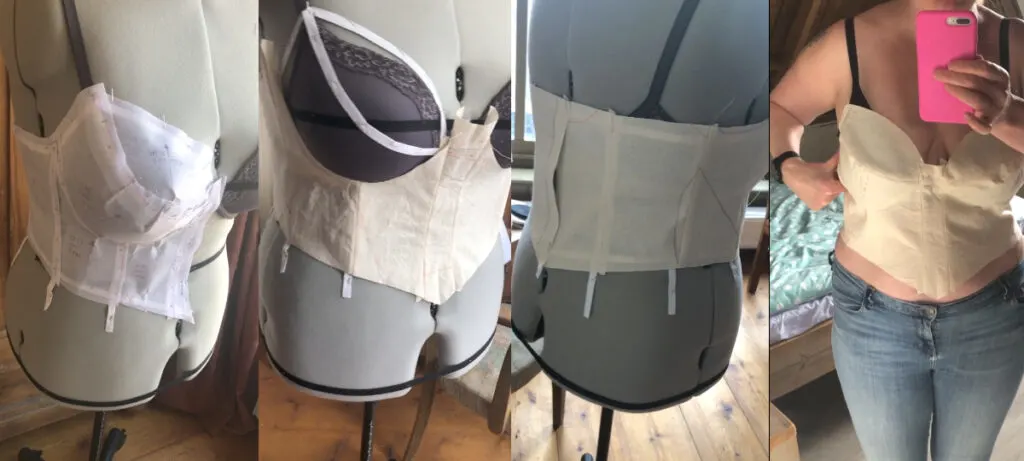I love draping. It’s the technique I discovered a talent for when I studied my fashion design degree, and it’s something I am passionate about teaching others.
Draping on a dress form is a great way to be more creative with your fashion design process whether you are a designer or someone who wants to create your own capsule collections.
So, if you’ve often wondered how to drape on a dress form, you’re in the right spot!
NB. I am referring to draping on a dress form throughout this article, NOT draping curtains or other home decor items!

What Are The Types Of Draping?
In the fashion context, there are two types of draping on the form:
- Draping – this is a great way to get creative using fabric to create a 3 dimensional form that isn’t conforming to the shape of the dress form, but rather working with it.
- Contouring – this is essentially draping but more stylised with a more closely fitted creation. Think corsets and body con – we’re conforming the fabric to the dress form.
Both techniques are fun to try out and experiment with.
What Fabric Is Used For Draping?

For draping, it is standard to use calico or muslin to drape with. In my online workshops, I teach how to drape on a dress form using a medium weight calico, which gives me a good amount of structure.
Ideally, once you have learned the basics of draping (ie the basic bodice and the straight skirt) you will in future want to choose a base fabric that is a similar weight and drape to your final fabric.
Think of the draped dresses of Alexander McQueen’s ‘Plato’s Atlantis’ fashion collection back in 2010! Not only were those dresses beautifully draped in silk, but they were also created with a print that was engineered to fit the draped pattern sections perfectly! A work of art!
What Fabric Is Used For Contouring?

For projects where you are contouring on the stand for a closer fit, I use a medium weight fusible interfacing from Vilene for several reasons:
- I can use a pen or pencil on it to make notes while working on the dress form
- It has no grain, so I have no issues with stretched fabric
- Because it is fusible, once I remove my work from the stand, I can gently press it so that it is fused to pattern paper – I teach this process in my online course if you’d like to learn more!
Preparing Your Dress Form
Before you start draping, you’ll need to prepare your dress form. You’ll want to use cotton twill tape, and mark in the following lines on your form:
- Centre front
- Centre back
- Side seams
- Shoulder line
- neckline
- Armscye
- Princess seam lines (front and back)
- Bust line
- Waistline
- Hip line
You can also use an adhesive tape, but I do not recommend this as it can often end up damaging your form. Twill tape is great because you can pin it in position nice and taught.
Preparing Your Fabric
Before you get started with draping it, you’ll need to prepare the correct amount of fabric.
To do this, you need to first measure your dress form.
Front Bodice Fabric
- The fabric width will be the crossgrain and relates to the girth of the dress form. Take the widest part of the form and measure from the centre front to the side seam. Add 10cm / 4 inches to the total.
- The fabric length will be the straight grain of the fabric and relates to the torso length. Measure from the neck / shoulder point down to the waist line. Add 10cm / 4 inches to the total.
- Prepare the fabric for the front bodice using these two measurements.
Back Bodice Fabric
The process is exactly the same as preparing for the front bodice, so repeat the steps above only use the measurements from the back of your dress form!
Balance Lines
I like to add balance lines to my fabric pieces before I start draping.
- Mark in straight lines parallel to the selvedge for the centre front and centre back lines on the fabric pieces. these should be around 3cm in from the edge.
- Mark in a line at 90º angle to this around the bust line point.
Draping The Front Bodice On A Dress Form

Now that your dress form is prepped, you’ll want to take your tools and fabric, and get to work on draping the front bodice first:
- Make sure that the fabric is on the correct grain.
- Place the line you marked in as centre front against the centre front and pin to secure.
- Work across the chest, smoothing the fabric as you go – but not stretching it! – and pin to secure at the front armhole.
- Work upwards to the mid shoulder line and again pin the fabric in place.
- Create a dart either from the front armhole to the bust point or the shoulder line to the bust point – this will shape the fabric to the form. Pin in place.
- Secure the fabric at the underarm point, and if the bust-line you marked in is parallel to the floor, you can smooth the fabric down towards the waist and pin.
- You’ll now have excess fabric in the front waist area so create a dart from this.
- Release the tension at the waistline with small snips from the fabric edge up to the waistline.
Draping The Back Bodice On A Dress Form

Now we work on draping the back bodice:
- Place the prepared fabric with the centre back line pinned to the centre back of your dress form.
- Make sure that the horizontal line you drew in is parallel to the floor, and smooth the fabric across to the back armhole. Add a pin to secure.
- Add a pin to what you think is the fullest part – usually around the shoulder blade point for context.
- Smooth the fabric up from this point towards the shoulder point and pin.
- You will likely now have excess fullness around the back neck – smooth this so that it falls between the neck point and mid shoulder and pin. This will be eased into the back shoulder line but for now create a small dart and pin in place.
- Now smooth the fabric down, and pinch the excess fabric at the back waist until a dart forms – pin to secure.
Connecting The Side Seams
You now need to connect the front and back sections at the side seams:
- Place a pin at the side seam along the bustline
- Add another halfway between the bust and waistline
- Finally connect the two with pins at the waist.
- Fabric should be smooth with no tension wrinkles!
Connecting The Shoulders
You’ll want three pins and place them as follows:
- At the point where neck joins shoulder.
- At the shoulder point – the pivot point of the arm!
- Midway on the shoulder line.
Marking The Fabric

You’re now ready to mark the fabric!
Grab a pen that is bold enough to mark the fabric clearly but not so bold that it will run through the draping fabric and mark the dress form.
Use the taped lines underneath as a guide and mark in all the key lines and points:
- Bustline
- Waistline
- Princess seam
- Bust point
- Front armhole
- Back armhole
- Shoulder
- Back neck
- Front neck
- Darts
- Balance marks (where two fabric pieces join)
Creating The Bodice Pattern
Your final task is to remove the fabric from the stand and transfer all the information to paper, creating a beautiful patten in the process.
Once created, do toile it up to check that you made no errors – this can then be used again and again to create some amazing designs.
Drape & Contour for Beginners

If you’d love to follow along with the draping process, then do check out my beginner friendly course Drape & Contour for Beginners.
In the course you’ll learn the different methods to drape the following on an adjustable dress form and a professional one too:
- Bodice block
- Skirt block
- Corset / bustier top
I’ll also be adding in future lessons too, covering draping the sleeve and a pair of pants, as well as draping for men too.
You can join my Drape & Contour for Beginners course here – I’d love to have you join me, but you can also jump onto the waitlist below for when my pattern making and design membership opens!
